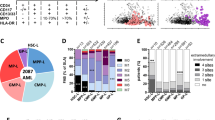Abstract
Differentiation inhibitory factor (nm23 protein) inhibited the induction of the differentiation of various leukaemic cell lines. We previously reported that nm23 genes (H1 and H2) were overexpressed in acute myelogenous leukaemia (AML) and nm23-H1 expression predicted the prognosis of AML, especially AML-M5. To clarify the correlation between French-American-British (FAB) classification and nm23 expression level and to clarify the involvement of nm23-H2 and nm23-H1 in patient survival, we investigated the relative levels of nm23-H1 and -H2 mRNA in 76 AML samples using the reverse transcriptase-polymerase chain reaction. We confirmed that the expression of both nm23-H1 and -H2 genes in AML samples from three different hospitals was significantly higher than that in normal blood cells (P < 0.0005). Overexpression of nm23-H1 was observed in each FAB AML-M1, -M2, -M3, -M4 or -M5 subtype, and the predictive effect of nm23-H1 expression on AML prognosis was shown in FAB AML-M2 and -M5 cases. Although overexpression of nm23-H2 was also found in each FAB subtype, the expression of nm23-H2 in AML-M1 and -M3 cells was not significantly higher than that in normal cells. Among AML subtypes, AML-M3 showed the lowest expression levels of both nm23 genes. To understand the relationship between nm23-H1 and -H2 expression levels, nm23 expression levels for all the AML cases were plotted and divided into four groups (group A, nm23-H1 and -H2 both high; B, both low; C, only nm23-H1 high; D, only nm23-H2 high). A statistically significant correlation between the levels of expression of nm23-H1 and -H2 was observed (r= 0.726). Most AML-M3 cases belonged to group B, but not other types of AML. Analysis of survival probability between the groups showed that group B survived for significantly longer compared with group A. Furthermore, AML-M3 cases survived for significantly longer compared with non-M3 cases in the same group B. These data suggest that low expression levels of both nm23-H1 and -H2 are associated with good prognosis in AML patients.
This is a preview of subscription content, access via your institution
Access options
Subscribe to this journal
Receive 24 print issues and online access
$259.00 per year
only $10.79 per issue
Buy this article
- Purchase on Springer Link
- Instant access to full article PDF
Prices may be subject to local taxes which are calculated during checkout
Similar content being viewed by others
Author information
Authors and Affiliations
Rights and permissions
About this article
Cite this article
Wakimoto, N., Yokoyama, A., Okabe-Kado, J. et al. Combined analysis of differentiation inhibitory factor nm23-H1 and nm23-H2 as prognostic factors in acute myeloid leukaemia. Br J Cancer 77, 2298–2303 (1998). https://doi.org/10.1038/bjc.1998.382
Issue Date:
DOI: https://doi.org/10.1038/bjc.1998.382
This article is cited by
-
Extracellular NME proteins: a player or a bystander?
Laboratory Investigation (2018)
-
The case for extracellular Nm23-H1 as a driver of acute myeloid leukaemia (AML) progression
Naunyn-Schmiedeberg's Archives of Pharmacology (2015)
-
Extracellular NM23-H1 protein inhibits the survival of primary cultured normal human peripheral blood mononuclear cells and activates the cytokine production
International Journal of Hematology (2009)
-
Elevated plasma level of differentiation inhibitory factor nm23-H1 protein correlates with risk factors for myelodysplastic syndrome
Leukemia (2002)



